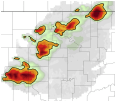Research Interests
Our group specializes in using numerical models to increase understanding of and improve our ability to predict high-impact weather phenomena, particularly hurricanes and severe storms. Our research interests in these areas are fairly broad, with current emphases including tropical-midlatitude flow interactions, tropical storm intensity change over land, and mesoscale convective system structural morphology.
 Tropical Cyclone-Midlatitude Flow Interactions
Tropical Cyclone-Midlatitude Flow Interactions
The interaction of a tropical cyclone with the antecedent midlatitude pattern can reconfigure the downstream flow over one or more synoptic-scale wavelengths, at times resulting in distinct high-impact weather events well removed from the tropical cyclone. This interaction is primarily diabatically driven with contributions from both cyclone- and thunderstorm-scale latent heating and associated circulations. With seed funding from UWM, we are using high-resolution CMIP6 climate-model outputs to evaluate how tropical cyclone-midlatitude flow interactions and subsequent downstream development will differ in a future climate.
 Overland Tropical Cyclone Intensity Change
Overland Tropical Cyclone Intensity Change
Tropical cyclones are primarily fueled by energy extracted from an underlying warm ocean. Although most tropical cyclones weaken after making landfall due to relatively high friction and a reduced ability to extract energy from the underlying surface over land, some tropical cyclones have reintensified over land. However, the precise physical processes at the land-atmosphere interface and in the upper soil that permit overland reintensification to occur are not yet agreed upon. With funding from NSF, we are using idealized and real-data numerical simulations to better understand these physical processes and quantify their predictability. We are also using reanalysis data to refine the climatology of these events.
 Mesoscale Convective Systems
Mesoscale Convective Systems
Mesoscale convective systems are important contributors to the warm-season precipitation climatology of the central and eastern United States. We are particularly interested in the structure and evolution of mesoscale convective systems’ rear-inflow jets, which typically form as a mesoscale convective system initially becomes tilted against the direction of the environmental vertical wind shear. With funding from the Dept. of Energy, we are using radar-derived observations and large-eddy-scale real-data numerical simulations to quantify the contributions of low-frequency gravity waves, line-end vortices, and the environmental flow to this rear inflow for mesoscale convective systems during MC3E and PECAN.
 Other Research Emphases
Other Research Emphases
Our group is also involved in a wide array of research projects that don’t fit neatly into one of our three emphases! We’re currently collecting observations to assess how the warm-season atmospheric boundary layer over Lake Michigan is structured, how that structure varies as a function of synoptic conditions, and how well high-resolution numerical weather prediction models are able to depict and forecast this structure. We’re also studying how meteorological seasons are defined from both physical and societal perspectives, with an eye toward assessing the overlap between severe-weather and hurricane seasons in the southeast United States and this overlap’s impacts to society.
For a full publication listing with accessible summaries, please see the Publications page. A simple publication listing is available in Dr. Evans’ Curriculum Vita. Citation information is available in Dr. Evans’ Google Scholar profile.
Recent Publications
Evans and Wood (2025)
Encyclopedia of the Atmospheric Sciences, 3rd Ed.
Blount et al. (2023)
Wea. Forecasting
- An objective method for clustering observed vertical thermodynamic profiles by their boundary-layer structure | local PDF copy
Kaminski et al. (2023)
J. Appl. Meteor. and Climatol.
Prince and Evans (2022)
J. Atmos. Sci.
- Convectively generated negative potential vorticity enhancing the jet stream through an inverse energy cascade during the extratropical transition of hurricane Irma | local PDF copy
Sarro and Evans (2022)
Mon. Wea. Rev.